The Chernobyl disaster that occurred in 1986 in Ukraine is one of the most well-known man-made disasters of the 20th century. However, most people are not aware of the current impacts that this disaster has had on the individuals in the surrounding populations. For example, the risk of individuals developing thyroid cancer in the affected areas seems to increase the closer they are located to the actual disaster.
To test this hypothesis, scientists at the Russian Academy of Science first used a geographic information system (GIS) to divide the areas of interest into four administrative regions, called “oblasts” in Russia. Then, they created a special information gathering system to study where and how common thyroid cancer is among the urban and rural populations of Russia that have been exposed to the nuclear fallout.
The information gathering system used the Unified State Register to map out the soil iodine status of the affected areas and rank them on a scale of 1-6, 1 being maximum I-127 concentration and 6 being minimum I-127 concentration. This data was then analyzed along with anonymized medical information regarding thyroid cancer cases from 1948 until 2020 from the Bryansk Clinical and Diagnostic Center to study the relationship between the two factors.
The nutrient iodine, known by chemists as iodine-127, is incredibly important for the thyroid gland to function. It is a key ingredient for building thyroid hormone, which controls the body’s metabolism. The most common radioactive material found at the Chernobyl site was iodine-131, a radioactive form of iodine. Excess iodine-131 can lead to cancer, especially thyroid cancer, as this is where most of the body’s iodine is present. Similarly, a deficiency of iodine, regardless of what kind, can also lead to thyroid cancer. Low iodine increases the chance of uncontrollable growth, which also increases the risk of mutations that could lead to tumor formation.
In this study, three main sources of iodine-127 in the population’s diet were examined: water sources that were used for drinking and household needs, milk from cows that were raised on private farms, and potatoes that were grown on private farms. The scientists suspected that the iodine that was found in the soil would be transferred to the crops that were grown in it, which would then be transferred to the humans that ingest it, either by eating livestock that ate the crops or by eating the contaminated crops themselves.
They measured the iodine-127 concentration of these three sources, and its concentration in soil samples from each of the urban and rural communities in the oblasts to determine the initial levels of iodine-127 that were present. These measurements would let them rule out a deficiency of normal iodine in the soil as a cause for the apparent increase in thyroid cancer in that area. The data from these experiments was analyzed alongside medical data from the Brynask Clinical and Diagnostic center, which consisted of anonymous information and demographics of cases of thyroid cancer in the population from 1948 to 2020.
The researchers expected that areas with the highest level of iodine-131 and the lowest of normal iodine would have the highest number of thyroid cancer cases. The authors determined that the Bryansk oblast had been contaminated with fallout the most, but there was variation in thyroid cancer incidence between the rural and urban communities within the Bryansk oblast.
From 2010 to 2018, the urban areas of the Byransk had a higher number of thyroid cancer cases (460.2 per 100 thousand) than the rural areas (449.2 per 100 thousand). This was different than what was expected as the rural areas had lower levels of iodine-127 in their soil, but had fewer cancer cases than the urban areas. This suggests that the cause of the thyroid cancer cases in urban areas is not directly linked to the iodine-127 that they receive from their diet.
However, the mortality rate was significantly higher in rural areas than in urban communities, which the researchers said may be explained by the urban population’s access to better medical treatment. Both of these results indicate that there may be other variables involved in increasing the risk of thyroid cancer in both rural and urban communities that had not been accounted for in this study.
The analysis provides evidence that we can successfully use geochemical and medical geoinformation systems to study the relationship between diseases and soil chemistry. The researchers suggest that contaminated crops might play a more significant role than previously thought in other diseases that are prevalent among people living nearby and therefore, should be studied as well.


